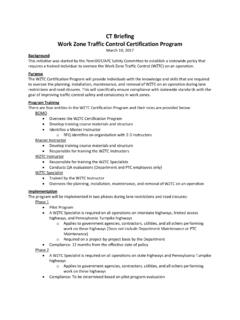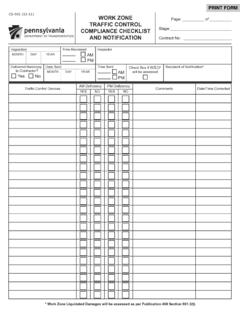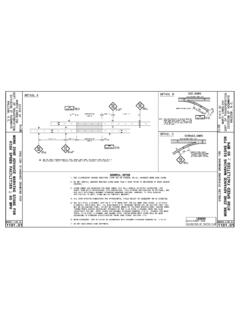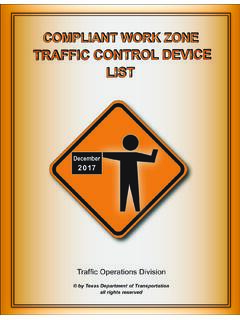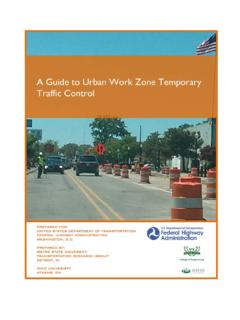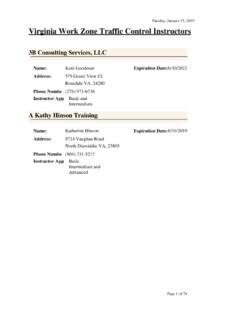Transcription of Work Zone Traffic Control Training Program
1 work Zone Traffic Control Training ProgramMarch 26th, 2018 Introduction What s the Purpose of Today s Webinar? Provide an overview of how the proposed work zone Traffic Control Training Program will impact day-to-day business Identify who all will be impacted Explain work zone Traffic Control Training requirements Evoke questions and comments from participants to refine policyIntroduction Why work Zone Training ? Authority Purpose Proposed Training Program 3 Categories of Training Training Requirements and Content External Training Courses & Instructor Qualifications Consequences for Non-compliance Program ManagementSection X References content in Draft work Zone Policy Document6187757748741,0088541,0431,0701, 0711,0611,067841051015202505001,0001,500 2,0002,500201220132014201520162017 FATAL CRASHESNUMBER OF CRASHESPA work Zone Crash Statistics All other roadsInterstates & PTC FacilitiesFatal CrashesWhy work Zone Training ? Reduce work zone crashes and fatalities Workers MotoristsPA work ZONE CRASH STATISTICS (12 -16 )PreliminaryResultsWhy work Zone Training ?
2 CRASH SEVERITY WITHIN THE work ZONE 2016 - 20176%,3%, 2%29%,18%, 15%BEFORE FIRST SIGN3%,9%, 9%41%,53%, 60%3%,4%, 3%Why work Zone Training ? Improve work zone consistency amongst all organizations within State & Turnpike right-of-way Improve work zone compliance with Publication 213 and MUTCDP rogram Goals and Objectives Goal: Provide the appropriate degree of Training for all work zone personnel involved with Traffic Control activities to properly and effectively conduct their job responsibilities. Objectives: Train all individuals who oversee Traffic Control , flagging, planning, design, installation, inspection, operation, management, maintenance, and removal of work zones . Reduce the number of fatal work zone crashes to zero. Reduce the number of overall work zone crashes each year. Reduce the number of unsatisfactory work zone QA/QC evaluations to zero. Improve work zone consistency amongst all organizationsSection 2 Authority Federal Regulations, 23 CFR Part 630J requires states to train all personnel involved with work zone activities to improve decision making for each individual s job responsibilities.
3 Section 2 Purpose Provide Training for allwork zone personnel who are involved in the following Traffic Control activities: Planning/Design of work zone Traffic Control Installation/Removal of work zone Traffic Control devices Maintenance/Inspection of work zone Traffic Control Operations/Management of work zone Traffic controlSection Impacted public agencies and organizations include: PennDOT PA Turnpike FHWA PA Municipal Organizations PA Public Utility Commission (PUC) PA State Police (PSP)Section Impacted private agencies and organizations include: Association of PA Constructors (APC) American Council of Engineering Companies (ACEC) Pennsylvania Asphalt Pavement Association (PAPA) American Traffic Safety Services Association (ATSSA) Highway Occupancy Permittees Any organization that conducts business within PennDOT or PA Turnpike right-of-waySection Training Program Provide 3 categories of work zone Training Field Personnel work Zone Safety Training Deployment & Oversight work Zone Safety Training Design & Review work Zone Safety Training Training required is dependent upon work zone job duties No pre-requisites for any category of trainingSection Training Program All individuals involved with work zone Traffic Control must maintain the appropriate work zone Training certification in order to perform work within State or PA Turnpike right-of-way Law Enforcement and Emergency/1stresponders are encouraged to receive work zone Training but not requiredSection Training Program Training techniques to be offered.
4 Web-based Training (free to trainees) Field Personnel work Zone Safety Training Instructor facilitated mixed methods Training (cost to trainees) Field Personnel work Zone Safety Training Deployment & Oversight work Zone Safety Training Design & Review work Zone Safety TrainingIMPORTANT: All Training courses utilize pre-recorded slides to ensure content consistencySection Training Program Field Personnel Training Requirements Who is required: All personnel controlling Traffic in a work zone and personnel responsible for installing, maintaining, and removing temporary Traffic Control devices Examples: Laborers involved with setting up and tearing down temporary Traffic Control devices and Flaggers Course objectives include: Understanding of required safety attire Understanding of work zone components Understanding of high level work zone concepts and overall safety awareness Understanding of proper way to install/remove Traffic Control devicesSection Training ProgramSection 8: Table 4 Module Content: Field Personnel TrainingTime (mins)Day 1 ( hours)1 Introduction102 Required Safety Attire53 Traffic Control Devices154 work Zone Components105 Worker SafetyAwareness206 BuildingWork Zone Skills30 Course Exam60 Proposed Training Program Field Personnel Training Course RequirementsSection Zone SafetyTrainingInstructionTestingTraining TechniqueInstructor RequiredMinimum HoursTesting TechniqueNumber of QuestionsTime Allowed (mins)Passing Score (%)ClassroomPracticalField Personnel TrainingWeb-based or aboveMixed or Written206080 or aboveIMPORTANT.
5 Personnel must complete Training every 3 years in order to maintain field personnel work zone Training certificationProposed Training ProgramSection 11 Field Personnel Training Implementation Online and assembly trainings available early Fall 2018 Supplements current flagger Training Flagger Training to be updated to incorporate field personnel content All new PennDOT employees involved with temporary Traffic Control must complete PennDOT maintenance divisions to conduct assembly trainings in Fall 2018/Winter 2019 Field Personnel Training must be completed by March 1st, 2020 Proposed Training ProgramSection Deployment & Oversight Training Requirements Who is required: All supervisory, decision-making, inspection, work zone QA/QC personnel, and individuals in charge of determining and laying out work zone Traffic Control set-ups in the field Examples: Project managers, Foreman, Superintendents, Engineer-in -charge, Inspectors, work zone QA/QC personnel Course objectives include: Understanding of human factors that contribute to crashes Understanding of relevant manuals, guidebooks, and publications Appropriate understanding and selection of Pub 213 PATAs Understanding project specific Traffic Control plans Modifying PATAs and Traffic Control plans for field conditions Installing/removing Traffic Control devices Understanding of inspection and documentation requirementsProposed Training ProgramModule Content: Deployment & Oversight TrainingTime (mins)Day 1 (6 hours)1 Introduction302 Liability and Risk303 Human Factors304A*PennDOT: Manuals and References304B*Turnpike: Manuals and References305 Traffic Control Devices606 work Zones607 Worker Safety and Flagging Operations90 Day 2 (6 hours)8A*PennDOT: Building work ZoneSkills (Tabletop/Field Demo)758B*Turnpike.
6 Building work Zone Skills (Tabletop/Field Demo)459 Adjusting TTC (Tabletop/Field Demo)6010 Types of TTC Activities3011 work Zone Inspection3012 Review of TTC Typical Applications60 Course Exam60*Agency specific modules may be removed based on course attendee applicabilityProposed Training Program Deployment & Oversight Training Course RequirementsWork Zone SafetyTrainingInstructionTestingTraining TechniqueInstructor RequiredMinimum HoursTestingTechniqueNumber of QuestionsTime Allowed (mins)Passing Score (%)Virtual/ClassroomPracticalDeployment & Oversight TrainingMixed MethodsY83 Electronic or Written406080 or aboveSection : Personnel must complete Training every 3 years in order to maintain deployment & oversight work zone Training certification* Training to occur over consecutive daysProposed Training ProgramSection A Deployment & Oversight Certified Individual mustbe on-site during installation, removal, or modifications of Traffic Control devices Program intends to provide at least one individual with Deployment & Oversight Training in a work zone at all times Where foreman/supervisors are responsible for multiple work zones , Deployment & Oversight Training is encouraged for field personnelProposed Training ProgramSection 11 Deployment & Oversight Training Implementation Assembly trainings available early 2019 Training to be incorporated into PennDOT s Foreman Academy Training Deployment & Oversight Training must be completed by March 1st, 2020 Proposed Training ProgramSection Design & Review Training Requirements Who is required.
7 All personnel with responsibility for design (includes PATA modifications) and/or review of work zone Traffic Control Examples: Design engineers ( Consultants, Contractors, Utilities, & Permittees) and District/PTC work Zone Review Staff Course objectives include: Understanding of relevant design manuals, guidebooks, and publications Review of work zone components and devices work zone mobility analysis and Transportation Management Plans Design considerations and detours Preferred Traffic Control Plan presentation and specifications Understanding of night-time, urban, and pedestrian/bicycle considerationsProposed Training ProgramModule Content: Design & Review TrainingTime (mins)Day 1 (6 hours)1 Introduction302A*PennDOT: Manuals and References302B*Turnpike: Manuals and References303 Fundamental Principles of work Zones304 Human Factors305 Component Parts of TTC306 TTC Devices607 Types of TTC Activities308A*PennDOT: TransportationManagement Plan(Group Exercises)308B*Turnpike:Transportation Management Plan (Group Exercises)309 Design Considerations30 Day 2 (6 hours)10A*PennDOT: TTC Plans and Specifications(Group Exercises)7510B*Turnpike: TTC Plans and Specifications (GroupExercises)4511 Nighttime WorkZones4512 Urbanand Other Considerations4513 CourseReview:TTC Designs, Plans, and Specifications90 Course Exam60*Agency specific modules may be removed based on course attendee applicabilityProposed Training Program Design & Review Training Course RequirementsWork Zone SafetyTrainingInstructionTestingTraining TechniqueInstructor RequiredMinimum HoursTesting TechniqueNumber of QuestionsTime Allowed (mins)Passing Score (%)Virtual/ClassroomPracticalDesigner& ReviewerTrainingMixed MethodsY83 Electronic or Written406080 or aboveSection.
8 Personnel must complete Training every 3 years in order to maintain design & review work zone Training certification* Training to occur over consecutive daysProposed Training ProgramSection 11 Design & Review Training Implementation Use Planning for Operations course as a baseline for new Training course Assembly trainings available early 2019 Design & Review Training must be completed by March 1st, 2020 Proposed Training Program External work zone Training courses may be accepted if PennDOT Training course content is included at a minimum PennDOT sWork Zone Unit or Program Administrator will approve all trainings PennDOTand PTC to meet periodically with impacted agencies/organizations to assess work zone Training Program and course content Potential to use work Zone Safety Technical Advisory Group PennDOThas the authority to update Training course requirements at any time in concurrence with PTCS ections Training Program Trainees that receive a failing score (79% or less)
9 Can take a makeup test within 48 hours Trainee certifications to be documented/tracked within a work Zone Training Program Database by Program Administrator Certificates will be presented to successful trainees by instructor Successful trainees will NOTbe required to carry a work zone Training card/certificateSections Training Program Trainings to be delivered by certified instructors Instructors must meet the following requirements:IMPORTANT: Training instructors need to be re-certified every 2 yearsWork Zone Safety TrainingPennDOT Certification RequirementsDocumentable Years of ExperienceFlagger TrainingTrain the TrainerField Personnel TrainingDeployment & Oversight TrainingDesign & Review TrainingField Personnel TrainingYYYYNAt least 2 years of in-field work zone experienceDeployment & Oversight TrainingYYYYYAt least 2 years of in-field supervisory or inspection experienceDesign & Review TrainingYYYYYAt least 4 years of WZTC design or review experienceSection Training Program Non-compliance with work Zone Training Program Policy requirements will result in individual and/or organizational consequences/penalties Consequences and penalties to be enforced per existing regulations and policies for: PennDOTM aintenance/ work Zone Staff PA Turnpike Maintenance/ work Zone Staff Non-PennDOT/PA Turnpike OrganizationsSection 7 Proposed Training Program PennDOT and PA Turnpike Consequences.
10 Individuals who fail to meet work zone safety, performance, or Training policy requirements will be subject the following: PennDOT: Individuals may be subject to discipline and/or termination as determined by Human Resources Policy and Process for a Needs Improvement and/or Unsatisfactory Quality Assurance and work Zone Traffic Control Reviews dated June 3, 2014 PA Turnpike: Individuals may be subject to an investigation and disciplinary actions as determined by Human Resources Incident will be documented in the WZ Training Program Database as wellSection Training Program Non-PennDOT/PA Turnpike individuals and organizations will be subject to consequences as noted in Publication 408 Section 105 Control of work Section (b) Competence of WorkerIMPORTANT: If first violation is egregious enough to endanger the safety of oneself, workers, or motorists, immediate suspension of individuals or stoppage of work may be necessarySection Training Program Engineer-in -charge, inspector, or designated representatives from PennDOT/PTC will enforce work Zone Training Policy Designated PennDOT/PTC representative will be responsible for documenting the incident in the their file and in the work Zone Training Program Training Program Organizations/agencies that repeatedly violate the work zone Training policy may be removed from the roadway, have work suspended, or have their pre-qualification status docked/suspended in accordance with: Title 67 Sections & Title 67 Sections & Publication 93 Section and Commission Specifications & and Training Program Program administrator will be contracted to
